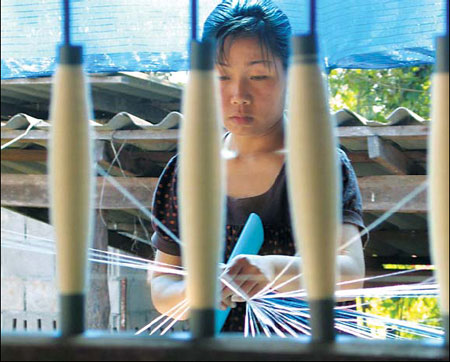Brand-new marketing idea to Asia becoming popular
|
At a weaving plant, thread is twisted to make Lamphun brocade silk. The technique dates back to the 19th century and the silk is prized by Thai royalty. DPA |
LAMPHUN, Thailand: What does Champagne, France's famous sparkling wine, have in common with brocade silk produced in northern Thailand? Not much, except that both products are protected by Geographic Indication intellectual property rights.
Lamphun brocade silk received a Geographic Indication (GI) certificate in October 2008 from Thailand's Intellectual Property Rights Department, making it one of 23 Thai products to be registered for domestic protection.
In southeast Asia, Thailand ranks first in terms of registered GIs, a little-known form of intellectual property right that is only beginning to take off in Asia.
"At first I didn't understand the idea of GI," acknowledges Salagan Parichatkeonak, owner of the Prichat Thai Silk company in Lamphun, 600 km north of Bangkok.
The company is one of six producers of Lamphun "yok dok", or brocade, silk that will probably qualify for the GI label once it has met all requirements set by the Lamphun Provincial Administration Organization.
"If I get the GI, I can raise my prices," says Salagan.
Lamphun brocade silk is famous in Thailand for its high quality and historical connections to the royal family, making it a target for copycats.
Using a unique technique of dying, twisted threads and expert weaving, dating back to the era of Thai King Chulalongkorn who reigned from 1868 to 1910, Lamphun brocade silk has found a special market among the Thai royalty.
It has featured for instance prominently in Queen Sirikit's wardrobe and was chosen to design six Thai traditional suits created for King Bhumibol Adulyadej, according to Thai silk expert Cheerachote Soontrak.
Brocade silk weaving was first introduced to Lamphun by Princess Dara Rasamee, Chulalongkorn's fifth wife who learned the process when she was in the Bangkok royal court.
Upon her return to northern Thailand, Rasamee taught the silk weaving techniques to her relatives in Lamphun.
The artisans of Lamphun have preserved their traditional silk weaving techniques over the decades, helping to qualify the silk for a GI certificate as a handicraft, unique to the province.
Geographic Indication has been around as an intellectual property right since the 1930s, when French wine growers appealed to their government to provide protection for well-known brands such as Bordeaux, Burgundy and Champagne in the aftermath of an insect plight that wiped out their grape crops, giving rise to a plethora of pretenders to meet demand.
In Europe, most GIs go to agricultural products, but the protection can also be applied to handicrafts.
For Lamphun brocade silk, GI means not only protecting their distinct product and being able to ask higher prices, but also potential tourism revenues.
"In the future we hope to promote silk as one of Lamphun's tourism attractions," says Cheerachote, director of Lamphun's Hariphunchai Institute of Hand-woven Fabric.
Unlike other forms of intellectual property rights, such as patents, copyrights and trademarks, GI is fixed to its place of origin, and cannot be "delocalized."
"What is here, stays here," says Stephane Passeri, programme administrator for the EC-ASEAN Intellectual Property Rights Cooperation Program. "If you registered Lamphun brocade silk as a trademark, it could be sold to a foreign company tomorrow and the production could be shifted from Thailand to India using the same name, and nobody would say anything."
Unlike most other intellectual property rights, GI is never given to a company, but rather to an association of producers who all come from the same area and make the same product.
The European Union has been helping introduce the concept of GI to the Association of Southeast Asian Nations (ASEAN) as part of their commitment to the Agreement on Trade Related Aspects of Intellectual Property Right (TRIPS) administered by the World Trade Organization.
TRIPS stipulates that the developed countries must help developing ones to protect their own intellectual property rights.
"GI is an interesting way of doing this because it plays on the advantages of the developing countries," says Passeri, whose programme has advised Cambodia, Indonesia, Malaysia, Thailand and Vietnam develop GI-related legislation and start the process of registering GI certificates.
The EU hopes to benefit by making ASEAN companies more aware of the need to protect their intellectual property rights and those of others.
"Doing a lot of work on GIs makes people more confident about the benefits of intellectual property rights," Passeri says.
DPA
(China Daily 02/05/2009 page10)















